With the passage of the Inflation Reduction Act and the EV tax credits that come with it, more Americans are going to make the switch to an electric vehicle. Here are our top picks for at-home EV charging stations that are easy to install, fast, and that come with important features like automatic reset.
Table of Contents
You bought an electric vehicle! Congratulations! Now, how are you going to charge it?
Unless you live in a super modern enclave with public EV charging stations peppered liberally about town and considerate fellow EV drivers who make sure to unhook and move their cars once fully charged, chances are you’re going to want to charge your EV at home.
Before we list our top picks for at home EV chargers, here are some tips on what to consider when buying an EV charger. The process of charging an EV at home is also a little more complicated than you might think.
How to charge an EV
The simplest way to charge your EV is to plug the 120 Volt charge cord that came with your car into a regular household outlet and wait… and wait… and wait. After an hour, you may have about 4-5 miles of battery life (or 8 km per hour charged). Hopefully, this is enough to get you to a store to buy a 240 Volt Level 2 charging station, which can charge your EV at more than twice the speed of a regular household outlet. Indeed, it will take you 12-20 hours to fully charge most EV batteries using a Level 1 charger (or 6-12 hours for a plug-in hybrid).
Having a Level 2 EV charging station at home is convenient (you can charge your car anytime you like, including overnight) and avoids the hassle of having to wait in line for an occupied public charger. A Level 2 charger charges at 30 km an hour, meaning it takes 6-14 hours to fully charge an EV battery (or 4-8 hours for a plug-in hybrid).
See also: Does your EV qualify for the $7,500 tax credit?
There are also fast chargers, known as Level 3 chargers, that use a direct current connection to an electrical system and can charge at 100 km per 30 minutes or 80% charge at 50 kW. It could take as little as 1-4 hours to fully charge your EV or 15 minutes to 3 hours for a plug-in hybrid. These types of chargers are, naturally, more expensive than Level 1 or Level 2 EV chargers and are usually only found in common areas and businesses rather than private residences.
J Plugs and Connectors for EV Charging
As more car manufacturers enter the EV market, the range of charger connectors also increases. Most EVs have a universal J plug (J1772), which works for almost every home and Level 2 charging station. Some cars work with a CCS plug (BMW, General Motors, and Volkswagen), and others work with a CHAdeMO plug (Mitsubishi and Nissan).
Teslas are typically charged using a Tesla charging station bought direct from the company. They can, however, be charged using the J plug or CHAdeMO plug and another EVSE brand, but you’ll need to get the adapter from Tesla.
If your EVSE will be outside, look for a charger with a holster that protects the J1772 connector, i.e. the plug on the end of the charging cord. And if you’ll need to charge two EVs simultaneously, look for a dual port EVSE.
Power outlets for EV chargers
If you’re looking to buy a Level 2 charger, bear in mind that it will need plugging into a 240 Volt outlet. If you’re in any doubt as to whether your home’s wiring can handle that much juice, consult an electrician first. Even if your electrical system has the capacity for a Level 2 charger, you may want to have some rewiring done to make a 240 Volt outlet more accessible and convenient for EV charging.
When buying EVSE for your home, you’ll notice that most product descriptions list how many amps the equipment provides. Amps are the flow rate for electricity, so the faster the flow the faster your EV will charge. Most EVSEs provide between 20 and 40 amps. In general, charging your EV for an hour at 20 amps will give you around 20 miles of driving. Charging at 40 amps for an hour would give you around 40 miles of driving. This is a rough calculation, but unless your car is exceptionally power hungry or very lean, the estimate works well.
If you’re leaning towards a lower amp system, perhaps because your current EV doesn’t take long to charge, think ahead a few years. You may want to upgrade to a new EV, someone else in your household may buy a new EV, or you may want to sell your home and highlight your EVSE as a bonus feature. Future-proof your system with a higher amp system if any of these things are likely.
Portability and EV charger cable length
Are you going to need to use your EV charger in more than one location, such as at a second home or work? If so, you’re going to want a plug-in EVSE rather than a hardwired EVSE. The plug-in charging stations plug into a 240 Volt wall outlet (like your clothes dryer does), meaning that you can unplug and take elsewhere fairly easily. These types of chargers are usually a bit pricier, but they are portable and easily repaired or replaced.
A hardwired EVSE may be necessary for an outdoor charging station, though. This kind of charger has an interior electrical connection and you don’t need to install a junction box behind any outlets. It can be a bit trickier, however, to repair or replace a hardwired charging station, so make sure to choose a good one and think carefully about where to install it.
EVSEs tend to come with 16-foot and 25-foot charging cables, with the longer cable costing a little more. When deciding which option to go for, consider where your EV will be parked when charging. Then consider whether you may need to charge a second EV and if you will need to move cars around to access the EVSE. If you’re charging two EVs every night, paying a little more up front for the longer cable can save you a lot of time, hassle, and domestic disputes in the long-run. Which brings me to the next consideration….
Location, location, location (for an EV charger)
Another key consideration when choosing an EV charger is where you’re going to install it. Unless your charger will live in your garage, you’re going to need a charger that can hold up to the elements. This means wind, rain, sun, snow, and critters too.
Thankfully, manufacturers label their EV chargers as outdoor rated or indoor only. For outdoor installations, look for a NEMA enclosure rating of at least 3 or 4. NEMA 4 is going to be more weatherproof than NEMA 3, but both should be OK for outdoor use.
A NEMA 4 rated enclosure provides a degree of protection against “falling dirt, rain, sleet, snow, windblown dust, splashing water, and hose-directed water [and] will be undamaged by the external formation of ice on the enclosure.”
Even if you are going to install the charger in your garage, consider whether this space is used for woodworking or other pursuits that could expose the charger to sawdust or other particulate matter, or to jets of water. It may still be a good idea to choose a NEMA 4 rated product even for an indoor installation in such cases.
Smart EV chargers with WiFi
Another factor to consider when buying an EV charger is whether you stand to benefit from a smart charger that’s WiFi enabled and can connect to your smartphone. Such stations typically have an associated app that gives you options to control scheduling, remote starting, and to set reminders.
If your utility company (or, say, a condo or office strata) has a time-of-use metering policy, this functionality is a godsend, letting you program charging for off-peak hours when electricity is cheapest. Of course, these WiFi functions only work when the signal at the charger is strong enough, so check before installing! Also, your EV itself may have remote start and scheduling options, so you might not need a charger to make use of these functions.
This can help you keep tabs on the charge level of your car, so you know when you’re ready to roll, or if the car isn’t charging properly. If you have two or more EVs at home, this kind of feature can help everyone stay on top of charging.
The best EV chargers for home use: our top picks
Here are my top picks for the best EV chargers for 2023. You can read about our unique research process here.
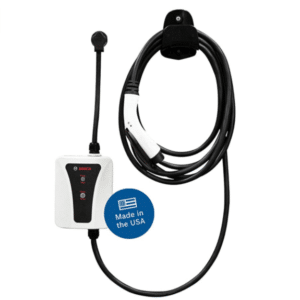
Bosch Level 2 Plug-in EV400 Charger Series
Highlights: New, more affordable EV400 line offers quality, speedy charging, and portability from an eco-minded company.
Regular readers of LeafScore.com will know that Bosch is one of my favorite eco-friendly companies. Bosch makes high-quality, innovative products in the US while leading the way in corporate social responsibility and environmental initiatives. The company also happens to make one of the best EV chargers available today, providing 32 Amps for speedy charging.
The Bosch Level 2 EV400 charger series was introduced in Spring, 2019 and has an even more compact, lean and clean design than the EV200 and EV600 series, in addition to being quite a bit less expensive (which was pretty much the only downside to the EV200 series!). These all work with any J1772 plug adaptor, meaning they work with all current and most older EVs, including BMW i3, Toyota Prius, Chevrolet Volt/Bolt, Ford C-Max/Fusion, Nissan LEAF, Tesla Model S/X (with Tesla supplied adapter), and more.
Charging stations are weather-resistant to NEMA 3R standard, meaning you can install this EVSE inside or outside. To ensure zero energy consumption when not in use, the Bosch charger has an off/on switch. There’s also a front plug to keep the connector clear of dirt and things like falling leaves, insects, etc. You can install this plug-in EV charger anywhere you have a 50 Amp 240 Volt receptacle and there’s built-in continuous ground fault protection; the EV400 detects a fault immediately and cuts power flow to keep your EV, home, and you safe from electric shocks.
Two options are available for the EV400 series:
- 25 ft Cable, 32 Amp
- 12 ft Cable, 16 Amp (the older model)
Both models are sleek, compact, weather-resistant, and the chargers have an automatic reset feature that detects power interruptions and resumes charging as soon as power is restored. So, no nasty surprises first thing in the morning when you need a fully charged car and the battery is dead. With a 7.6 kW output, you can charge your EV up to six times faster than standard plug-in charging.
The thing I really like about the Bosch EV400 plug-in is that it’s super easy to install. This small unit mounts directly on a wall with just two screws. So, you can get this thing out of the box and up and running within minutes. Just be sure to mount it next to your 50 Amp 240 Volt outlet!
Bright, clear LED indicator lights let you know your charging status at a glance, with lights for charging, fully charged, and standby. As you’d expect with Bosch, the quality of the electronics is high and the EV400 includes self-testing and diagnostics circuitry, which is automatically performed prior to each charging cycle. The charger is cUL and UL (Underwriters Laboratory) listed and meets NEC 625. The downsides? The Bosch Level 2 charger only has a 3R NEMA rating. So, if you plan on installing this in an area where the charger may be inadvertently blasted by water or subject to fine dust particles (such as in a garage or near a hose bib), consider the ClipperCreek charger instead.
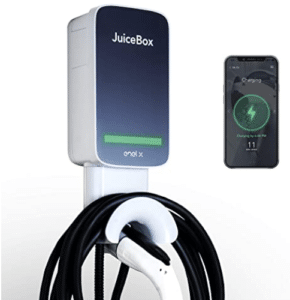
Enel X JuiceBox Pro 40A
Highlights: High-quality EV charger made in the USA, suitable for outdoor use, with hardwire or plug-in options and distinct advantages to both!
The JuiceBox 40A Next Generation Smart Electric Vehicle (EV) Charging Station with WiFi is a Level 2 EVSE new for 2020. These chargers provide 40 Amps via a 25-foot cable (or 32 Amps in the older model). The 40 is a hardwire installation while the 40A is a plug-in version. Both are UL & Energy Star Certified and suitable for indoor or outdoor use with a NEMA 4 / IP66 rating.
The JuiceBox Pro chargers offer 9.6 kW and can charge your EV seven times faster than just plugging in your regular cable to a 120 Volt wall outlet. These chargers have a built-in cable rack and security lock, making them a good choice for communal parking spaces, and they come with a 3-year limited warranty for normal residential use.
The WiFi connectivity and the free JuiceNet app available for the Pro model (not the Classic) lets you control and monitor charging remotely and will send you an alert when your car is fully charged. You can also control charging via Alexa and Amazon Echo, and there are options to schedule charging for off-peak hours to take advantage of rate savings.
Dynamic LED lights show charging status on the console. The system is designed to work with the universal J1772 charging standard.
With the hardwired option, you can share charging load among two or more chargers without adding an additional circuit. The hardwired option has to be installed by a professional electrician, and the input cable is 1.7 feet long. The circuit needs to have enough capacity to handle an additional 50 Amps and the circuit breaker needs to be 125% of the rated, continuous load of the installed equipment.
If you already have a 240 Volt outlet (for your dryer, say), the plug-in JuiceBox is arguably the better option. It is smaller than many other models, measuring 5.3 x 6.8 x 18.5 inches, making it an attractive portable option.
The JuiceBox Pro 40 is also built in the US and features sturdy aluminum and a waterproof enclosure. The plug is NEMA 14-50 rated or you can choose the optional NEMA 14-30 or 10-30 plugs.
JuiceBox also offer the JuicePoints program, where you can actually earn cash for smart charging in certain locations.
The only downsides to the JuiceBox are that it’s a bit pricier than the Bosch and the company doesn’t have anything like the same eco-friendly track record.
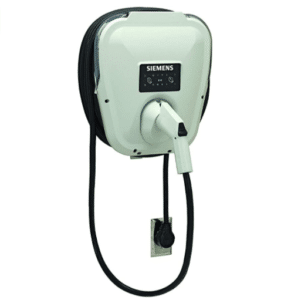
Siemens VersiCharge Home Charger
Highlights: NEMA 4 rated, made with some recycled materials, by a trusted company and with a 3-year warranty.
Siemens are another big name in electronics, with more than 170 years in the business and a reputation for innovation, quality, and reliability. The company has focused a lot of its efforts on green tech in recent years and claims that around 40% of its revenue now comes from green products like the Siemens Versicharge 30-Amp electric vehicle charger, which is manufactured in California and comes with a 3-year warranty.
This charger is available as a Hardwire (VC30GRHW) unit suitable for indoor use, a Universal plug-in (VC30GRYU) unit suitable for indoor or outdoor use, and a Smart Grid (VCSG30GRYUW) model that is plug-in and WiFi connected. All of the models require a 240 Volt receptacle and have a 30 Amp output. They can all be fairly easily mounted on most surfaces with the mounting bracket provided and the universal connector J1772 means you can charge all current EVs and most older EVs in just a few hours.
The control panel is simple, with an on-off button and a button for the charge delay feature. The Versicharge also has a status halo so you can tell from a distance if it is connected, charging, or if there’s a fault. While this charger is a bit bulkier than some, that’s largely because it features a handy cord management solution to keep things tidy.
The delay feature lets you postpone charging for up to 8 hours from the time of plug-in. So, you can get home from work, plug in the car, push a button to delay charging for 2, 4, 6, or 8 hours, and rest assured that your car will charge overnight when electricity is a little cheaper. This delay feature may not work for some EVs, though, so check first. The Smart Grid charger lets you use a smartphone app to monitor, schedule, and adjust your charging.
The Universal and Smart Grid Versicharge models are NEMA 4 rated and made of 60% recycled material with a matte finish designed to withstand the elements. There’s an integrated holster to keep debris and dust out of the plug, and you get a 20-foot cord on the plug-in models and a 14-foot cord on the hardwired model. The Versicharge lets you adjust the output from 1.8 kW to 7.2 kW and allows for adjustable, extended amperage options, which helps future-proof the EV charger in case you upgrade your vehicle later.
The chargers come with a mounting bracket and a digital manual on a reusable USB stick. They can be configured for wiring at the base or at the rear, measures 16.5 x 16.5 x 6.5 inches, and weighs 21 pounds. Operating temperatures are from -30 Celsius to 50 Celsius, and below 95% non-condensing humidity.
The only real downside to the Universal Versicharge is its size, which is quite a bit larger than the JuiceBox and the Bosch EV400. So, if you’re looking for the best EV charger for use at home but might need to take it with you on occasion, make sure you’re comfortable packing this one to go. The Smart Grid Versicharge is quite a bit more expensive than other smart EV chargers. And, overall, the Siemens Versicharge series will take a tad longer to charge your EV than the 40 Amp chargers on this list.
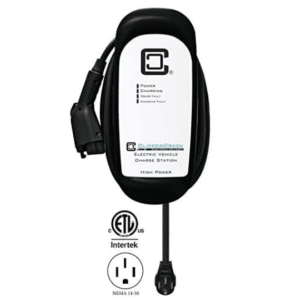
ClipperCreek HCS-40 EV Charging Station
Highlights: NEMA 4 rated EV charging station ideal for communal and outdoor EV charging.
Made in America, the ClipperCreek HCS-40P, 240V, 32A, EV Charging Station offer 5.5 times faster charging than your regular EV cable in a 120 Volt outlet. It uses the universal J1772 connector and works with all current EVs and most older EVs (with a Tesla adapter for Tesla models) and provides 32 Amps of power and 7.7 kW.
The ClipperCreek is NEMA 4 rated and backed by a 3-year warranty. It’s a great option for outdoor EV charging stations and comes with a 25-foot charging cable and neat cable stowage as well as a wall mount connector holster to keep the connector clean and clear of debris and dust. The connector also accommodates a specially sized padlock (provided!) for added security. So, if you’re installing an EV charging station in a communal parking spot, ClipperCreek is a great choice.
The service ground monitor continually checks for proper safety ground and shuts off if a fault develops that could cause an electrical hazard. There’s also an automatic circuit reclosure to restore charging after minor power faults, and self-testing to eliminate the need for manual user testing.
The ClipperCreek can operate at temperatures from -30 Celsius to 50 Celsius (-22 Fahrenheit to 122 Fahrenheit). This EV charger measures 9 x 19.7 x 5.3 inches, making it a tad smaller than the Siemens but bigger than the Bosch.
The hardwire version (HCS-40) comes with a 3-foot flexible cable to plug into a receptacle, but this is restricted to the bottom of the device, so be sure it will fit where you want it (View Price on Amazon). The HCS-40P is a plug-in unit available with either a NEMA 14-50 or NEMA 6-50 plug (View Price on Amazon). The plug-in model is recommended for indoor use only.
ClipperCreek is one of the original companies making EV charging stations and has a reputation for great customer service, reliability, and the ruggedness of their EV chargers. Indeed, the company offers a specialized version of this charger for extreme weather conditions (at a pretty penny, mind you). If you go for a lower output 32 A model, you can also opt for a dual charging station with two connectors, or you can connect two units to the same circuit. ClipperCreek also offer double the amperage with their HCS-80 hardwire 64 Amp unit for super fast charging (view on Amazon).
The downsides to the HCS-40 line? These are no-frills EV chargers, meaning no WiFi connectivity, charge delay options, or anything else that’s becoming standard with most EV chargers. So, if your car is already capable of all those things and you want to avoid a smart charger, the ClipperCreek is a good option (albeit a bit expensive, given the lack of frills). If you might upgrade your car soon or add another household EV that might not have smart features like these built-in, consider the JuiceBox or Bosch instead. Also, bear in mind that some customers have reported problems using their charge delay feature with the ClipperCreek charger, so check before buying.
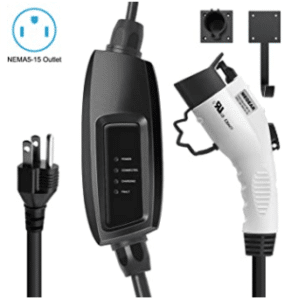
Zencar Portable EV Charger
Highlights: Super affordable and portable EV charger with no frills but some rare and old adapter options that might be perfect for older outlets.
One of the most affordable EV chargers around, the Zencar is highly portable, comes with a wide assortment of plugs, and can provide up to 16 Amps. There’s also an inexpensive no-frills wall-mounted 32 Amp option (View Price on Amazon), for which you’ll need the NEMA-14-50 cable instead of the L14-30, NEMA 6-20, 10-30, and 14-30 plug versions, which are all 16 Amp Level 2 chargers.
The Zencar comes with a 25-foot cable that is protected against leakage, overheating, overvoltage, overcurrent, and is waterproof, surge-proof, and flame resistant. If you have an old or odd outlet or electrical supply, the Zencar could be just the ticket, given its wide array of available plug options with the 16 Amp model (View Price on Amazon).
Downsides? Unlike most of the other chargers on this list, the Zencar only comes with a 24-month warranty, but the company does offer lifetime tech support. The Zencar is also only for use indoors and is not provided in a weatherproof enclosure. There’s also no WiFi or other smart functions.
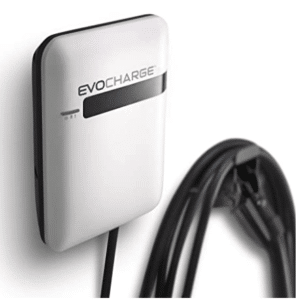
EVoCharge Level 2 EV Charger
Highlights: NEMA 4 rated for outdoor use, simple to install, made in America, and can be hardwired or plug-in.
EVoCharge are another US-based company (in California) specializing in EV chargers. Their latest Level 2 charger offers 7.68 kW of charging capacity, helping you charge your EV around 8 times faster than a standard connector (View Price on Amazon).
Easy to install, the EVoCharge has a simple mounting bracket and supports multiple current ratings up to 40 Amps. It comes with a standard NEMA 6-50 plug and is NEMA 4 outdoor rated with an 18-foot or 25-foot cable. It can also be hardwired and has a connector holster and on-off switch.
UL tested (and ETL for Canada), the EVoCharge has a super slim design (smaller than a sheet of paper), making it a good choice for awkward narrow spaces. It is another no-frills model, so no WiFi or charge delay capacity. It does come with a 3-year warranty though, and is compatible with all EVs and PHEVs sold in the US and Canada (you’ll need that pesky Tesla adapter though).
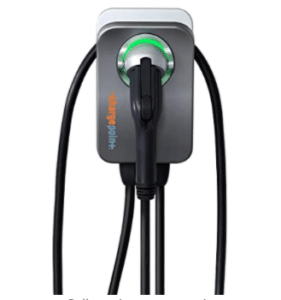
ChargePoint Home Flex WiFi Enabled EV Charger
Highlights: Hardwearing, hardworking, smart EV charger from a tried and tested company that has long provided public EV charging stations (but a bit pricy and only controllable through the app).
The ChargePoint Home Flex EV Charger provides up to 50 Amps, charging your EV nine times faster than the standard plug, at a rate of up to 37 miles of range per hour of charging. This charger is WiFi enabled, UL and Energy Star listed, and is available as a plug-in or hardwire unit. It connects to Nest thermostats too, which can give you energy nerds out there a handy monthly energy usage report.
The ChargePoint has LED indicators to show if the EV is connected, charging, ready, or if there is a fault. Controls are all through the app, with no buttons on the device itself. You can set a schedule and charge only when electricity is cheap, and you can use Alexa voice control to check in and control the charger remotely.
The system can be installed to charge up to 50 Amps, so you can adjust as needed for your home’s energy supply. ChargePoint Home Flex uses a universal J1772 connector and works with all current and many older EV models, including the Chevrolet Bolt EV, Chevy Volt, Hyundai Kona, Kia NIRO, Nissan LEAF, Tesla (with their adapter), Toyota Prius Prime and more.
The ChargePoint has a 3-year warranty and 24/7 customer support from an EV-charging focused company. It is NEMA 3R weatherproof rated, for indoor and outdoor installations, and comes with a 23-foot charging cable. It works with either a NEMA 6-50 or 14-50 plug (your choice), which can be removed for hardwired installation.
This EV charger is eligible for whole host of utility rebates, so could pay for itself quite quickly. ChargePoint have a host of public EV charging stations across the US, so make sure to take advantage of the ChargePoint app, which can help you locate and pay for public charging stations if you’re away from home.
The key downside to the ChargePoint is the lack of control at the device itself. The default amperage is 16 A but during set-up you can select your amperage up to 50 A. The problem, though, is that whatever you select in set-up becomes your default from then on, meaning that there’s no manual way to reset things if a fault occurs.
Is an at-home EV charger worth the money?
Installing an EV charger at home isn’t free, but it’s worth the investment, especially if you use your EV most days and/or go for long drives where you need a full battery charge. If you have a plug-in hybrid electric vehicle, it’s debatable as to whether you need a Level 2 charging station at home. That said, if you already have a solar array hooked up or you install one on your carport, you could be charging your car for free in no time.
Once you decide to take the plunge and get an at-home EV charger, you’ll want to look into tax rebates, credits, and other incentives. If you haven’t already, take a look at my breakdown of EV tax credits for 2023. Some states, cities, and towns offer incentives available both when buying an EV and when installing EV supply equipment (EVSE – or an EV charging station) at home.
Many states have grants, tax breaks, and reduced utility rates available for anyone installing and using an EV charger at home or at their business. If that’s the case, check the list of approved EVSEs from your utility company against my top picks for EV chargers, to make sure your chosen charger qualifies.
Very helpful!! Thank you. I too want to affect more clean energy transportation. I just kesded a Chevy Bolt and am learning how to charge and use it efficiently. I’m grateful for this informative in-depth info.
I like how you mentioned that choosing a location is important to prevent making mistakes. One of my parent’s friends told me that he is planning to have an electric vehicle charger installed in their business workplace for quick-turnaround charging, and he asked if I have any idea what is the best option to consider. I wanted to thank you for your explanation, I’ll be sure to tell him that he can consult a trusted electric vehicle charger installation service.